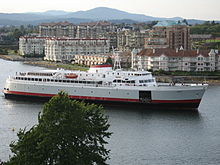|
MV Coho
  The MV Coho is a passenger and vehicle ferry owned and operated by Black Ball Line.[2] Black Ball's only ferry, Coho carries passengers and cars, motorcycles, trucks, semi-trailers, bicycles, etc. between Victoria, British Columbia, Canada and Port Angeles, Washington, United States. Coho makes between two and four round trips from Port Angeles to Victoria daily, with each crossing taking about 90 minutes and covering 37 kilometers or 20 nautical miles. The peak summer season has the most trips per day and the winter season the fewest. Passengers are not allowed to access the car deck during the journey.[3] Construction and designCoho was designed by Philip F. Spaulding & Associates, of Seattle and is named after the coho salmon commonly found in the United States' Pacific Northwest. Coho was the first large vessel built on the West Coast in 20 years solely with private financing. The vessel was built by Puget Sound Bridge and Dredging Company in Seattle, Washington and made her first sailing to Victoria, British Columbia on December 29, 1959. She was originally powered by two Cooper-Bessemer diesel engines rated at 2,080 brake horsepower (1,550 kW) each. In 2004 she was refitted with two V-12 Electro-Motive Division (EMD)12-645F7B diesels rated at 2,550 hp (1,900 kW) each. Coho has twin 8-foot (2.44 m) stainless propellers with twin rudders. Her overall length is 341.5 feet (104.1 m) with a service speed of 15 knots (28 km/h; 17 mph). The ship's vehicle clearance is 14 feet (4.27 m) with a carrying capacity of 110 vehicles and up to 1,000 passengers.[4][5] The design of Coho was the basis for that of BC Ferries' first two ships, the Sidney-class Queen of Sidney and Queen of Tsawwassen,[6] which developed into the V-class ferry. Terrorist incidentCoho made news on December 14, 1999, when Ahmed Ressam was arrested by border authorities in Port Angeles, Washington after he attempted to enter the United States via Victoria on Coho with home-made explosives and timing devices hidden in his car. He admitted he and accomplices had planned to bomb Los Angeles International Airport on New Year's Eve, 1999.[7] Notes
External linksWikimedia Commons has media related to IMO 5076949. |
||||||||||||||||||||||||||||||||||||||||
